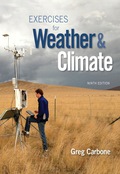
- a. The Sun has an average surface temperature of 6000 K. How much radiation is emitted from this surface?
- b. How much radiation is emitted from Earth’s surface at 300 K?
a)
The amount of radiation emitted from the surface of the Sun, given the average surface temperature of Sun is 6000 K.
Answer to Problem 1E
The radiation emitted by the Sun at 6000K is
Explanation of Solution
Electromagnetic energy is radiated from the Sun, and it reaches the surface of the Earth in the form of visible radiations. Initially, the spectrum contains all types of wavelengths, and the atmosphere filters out certain wavelengths.
The emission of radiation by a body can be understood from Stefan–Boltzmann law. This law states, “Energy emitted by a body is directly proportional to the fourth power of temperature”.
Here,
The formula to calculate the radiation emitted by the Sun at 6,000K is expressed below:
Substitute
Therefore, the radiation emitted by the Sun at 6000K is
b)
The amount of radiation emitted from the Earth’s surface at 300 K.
Answer to Problem 1E
The radiation emitted by the Earth’s surface at 300K is
Explanation of Solution
Refer to subpart ‘a’ for description regarding Stefan–Boltzmann law.
The formula to calculate the radiation emitted by the Earth’s surface at 300K is expressed below:
To find the radiation emitted by the Earth’s surface at 300K, substitute
Therefore, the radiation emitted by the Earth’s surface at 300K is
Want to see more full solutions like this?
Chapter 3 Solutions
EBK EXERCISES FOR WEATHER & CLIMATE
Additional Science Textbook Solutions
Microbiology: An Introduction
Microbiology: An Introduction
Microbiology with Diseases by Body System (5th Edition)
Anatomy & Physiology (6th Edition)
Laboratory Experiments in Microbiology (12th Edition) (What's New in Microbiology)
Introductory Chemistry (6th Edition)
- Prompt: Using a visual art medium of your choice, please describe or explore any environmental issue or topic of your choice. Please ensure 100% human donearrow_forwardPrompt: Using a visual art medium of your choice, please describe or explore any environmental issue or topic of your choice. Please ensure 100% human donearrow_forwardPrompt: Using an online art style of your choice, please make a meme related to the study of Geography, Environment, or Geomatics. Please ensure 100% human donearrow_forward
- Using a visual art medium of your choice, please describe or explore any environmental issue or topic of your choice.arrow_forwardUsing an online art style of your choice, please make a meme related to the study of Geography, Environment, or Geomatics.arrow_forwardidentify the 2 rocks in the photoarrow_forward
- Draw several strike-dip symbols on Figure 6.14 that would be appropriate for a dome and a basin, respectively.arrow_forwardChoose two vehicles to compare. One being a gas powered one being electric. No hybrids. With the media of your choosing compare and contrast the two vehicles emissions and pollution factors. Key words are Hydrocarbon, Carbon, Hydrogen, Asthma, Infection, Pollution, and Global warming.arrow_forwardEvaluate the advantages and disadvantages of gas and electric cars.arrow_forward
- charles darwin, what did he doarrow_forwardWhile Chapters 8 and 9 consider almost purely endogenic processes, Chapter 10 takes us further out from the center of the Earth to exogenic processes. My sister and I were out for a walk when we decided to cut through the cemetery. I could not help but wonder why the tombstones below are so different. While both tombstones are roughly the same age, the top one is made out of limestone while the bottom one is made out of granite. However, the one above looks much older due to a difference in the rate of weathering. Limestone is made out of the mineral calcite, CaCO3, calcium carbonate. Reads "1884" Dieds JOSEPH HERRING 1842-1911 JULIA HERRING 1843 NELLIE HERRING 1870-1882 Reads "1882" The tombstone in better condition here is made out of granite. Granite contains minerals such as quartz and feldspar. Both tombstones experience the same climate conditions and have been exposed to exogenic processes for the same amount of time yet they look so different! Some research into Chapter 10…arrow_forwardDiscussion Question: Tectonics, Earthquakes and Volcanism A+ The image below can also be found in your textbook. This image is not an interpretation but an actual picture of the Red Sea. This area of the world is the East African Rift Zone separating Saudi Arabia and Africa. The linear pattern is due to extensional tectonics. In other words, Africa and Saudi Arabia are moving away from each other creating tensional forces that create normal faults. The landscape features found in the area are Rift Valleys. Pretend we are on location at the East African Rift Valley. We would find Normal Faults where one side of the fault shows a rock layer dropped relative to the other layer. We would find linear mountains that formed from the valley dropping out between the normal faults. The microscale evidence we collect helps to add up to the macroscale interpretation of a divergent boundary due to tensional forces creating normal faults and rift valleys.arrow_forward
 Applications and Investigations in Earth Science ...Earth ScienceISBN:9780134746241Author:Edward J. Tarbuck, Frederick K. Lutgens, Dennis G. TasaPublisher:PEARSON
Applications and Investigations in Earth Science ...Earth ScienceISBN:9780134746241Author:Edward J. Tarbuck, Frederick K. Lutgens, Dennis G. TasaPublisher:PEARSON Exercises for Weather & Climate (9th Edition)Earth ScienceISBN:9780134041360Author:Greg CarbonePublisher:PEARSON
Exercises for Weather & Climate (9th Edition)Earth ScienceISBN:9780134041360Author:Greg CarbonePublisher:PEARSON Environmental ScienceEarth ScienceISBN:9781260153125Author:William P Cunningham Prof., Mary Ann Cunningham ProfessorPublisher:McGraw-Hill Education
Environmental ScienceEarth ScienceISBN:9781260153125Author:William P Cunningham Prof., Mary Ann Cunningham ProfessorPublisher:McGraw-Hill Education Earth Science (15th Edition)Earth ScienceISBN:9780134543536Author:Edward J. Tarbuck, Frederick K. Lutgens, Dennis G. TasaPublisher:PEARSON
Earth Science (15th Edition)Earth ScienceISBN:9780134543536Author:Edward J. Tarbuck, Frederick K. Lutgens, Dennis G. TasaPublisher:PEARSON Environmental Science (MindTap Course List)Earth ScienceISBN:9781337569613Author:G. Tyler Miller, Scott SpoolmanPublisher:Cengage Learning
Environmental Science (MindTap Course List)Earth ScienceISBN:9781337569613Author:G. Tyler Miller, Scott SpoolmanPublisher:Cengage Learning Physical GeologyEarth ScienceISBN:9781259916823Author:Plummer, Charles C., CARLSON, Diane H., Hammersley, LisaPublisher:Mcgraw-hill Education,
Physical GeologyEarth ScienceISBN:9781259916823Author:Plummer, Charles C., CARLSON, Diane H., Hammersley, LisaPublisher:Mcgraw-hill Education,





